Nuestra conclusión
Pros
- Amortiguación de ensueño
- Lengüeta elástica y cómoda
- Muy buen agarre
- Estables hasta decir basta
- Ideales para carreras de larga distancia
- Perfectas para los talonadores
- Buena relación calidad-precio para ser unas superzapatillas de entrenamiento
- Buena relación calidad-precio para ser unas superzapatillas de entrenamiento
Contras
- Más pesadas que la mayoría de sus competidoras
- La suela exterior se desgasta rápido
- Carecen de agilidad
- El retorno de energía de la espuma Nitro no es suficiente
Veredicto de los usuarios
- Top 11% entre Zapatillas de running para asfalto
- Top 9% entre zapatillas de running neutras
Comparativa
Las zapatillas de running más parecidas
+ + Añadir unas zapatillas | |||||
|---|---|---|---|---|---|
| Puntuación global | 91 Excelentes | 89 Notables | 90 Excelentes | 90 Excelentes | |
| Precio | 190 € | 170 € | 220 € | 190 € | |
| Pace | Correr a diario | Correr a diario | Correr a diarioTempo / series | Correr a diario | |
| Absorción de impactos | Alta | Alta | Moderada | Alta | |
| Retorno de energía | Moderado | Moderado | Alto | Moderado | |
| Tracción | Alta | Alta | Alta | Alta | |
| Arch support | Neutral | Neutral | Neutral | Neutral | |
| Peso laboratorio Peso marca | 10.3 oz / 291g 10.3 oz / 292g | 9.9 oz / 282g 10 oz / 283g | 8.9 oz / 252g 8.8 oz / 250g | 9.6 oz / 272g 9.7 oz / 275g | |
| Drop laboratorio Drop marca | 9.6 mm 8.0 mm | 8.7 mm 5.0 mm | 8.2 mm 8.0 mm | 9.4 mm 6.0 mm | |
| Técnica de carrera | TalónMedio/antepié | TalónMedio/antepié | TalónMedio/antepié | TalónMedio/antepié | |
| Talla | Tallan bien | Tallan bien | Tallan bien | Tallan bien | |
| Rigidez de la mediasuela | Blanda | Blanda | Blanda | Equilibrada | |
| Diferencia de la rigidez de la mediasuela en frío | Grande | Normal | Pequeña | Pequeña | |
| Durabilidad de la parte delantera | Decente | Decente | Buena | Decente | |
| Durabilidad del acolchado del talón | Media | Alta | Alta | Baja | |
| Durabilidad de la suela exterior | Decente | Buena | Buena | Buena | |
| Transpirabilidad | Media | Alta | Alta | Media | |
| Anchura / ajuste | Media | Media | Media | Media | |
| Anchura de la parte delantera | Media | Estrecha | Media | Media | |
| Flexibilidad | Rígida | Rígida | Rígida | Rígida | |
| Rigidez torsional | Rígidas | Rígidas | Rígidas | Rígidas | |
| Rigidez del contrafuerte del talón | Moderado | Rígido | Moderado | Moderado | |
| Rocker | ✓ | ✗ | ✓ | ✓ | |
| Talón laboratorio Talón marca | 42.9 mm 47.0 mm | 39.3 mm 39.0 mm | 42.8 mm 45.0 mm | 39.9 mm 37.0 mm | |
| Antepié laboratorio Antepié marca | 33.3 mm 39.0 mm | 30.6 mm 34.0 mm | 34.6 mm 37.0 mm | 30.5 mm 31.0 mm | |
| Anchuras disponibles | Estándar | EstándarAncho | EstándarAncho | Estándar | |
| Orthotic friendly | ✓ | ✓ | ✓ | ✓ | |
| Estación | Todas las estaciones | VeranoTodas las estaciones | VeranoTodas las estaciones | Todas las estaciones | |
| Removable insole | ✓ | ✓ | ✓ | ✓ | |
| Clasificación | #31 Top 9% | #113 Top 31% | #76 Top 21% | #40 Top 11% | |
| Popularidad | #135 Top 36% | #117 Top 32% | #22 Top 6% | #203 45% inferior |
Quién debería comprárselas
Teníamos unas ganas locas de analizar las zapatillas más grandes que Puma ha sacado hasta la fecha, y nos han parecido perfectas para:
- Los corredores que quieren mucha amortiguación: el diseño maximalista de las MagMax Nitro tiene de sobra.
- Los que están buscando unas superzapatillas de entrenamiento que pongan la estabilidad y la sujeción antes que la velocidad y la agilidad.
- Los corredores de larga distancia a los que no les gusta el contacto con el suelo y necesitan unas zapatillas ultra amortiguadas para las carreras largas y las sesiones de recuperación.

Quién NO debería comprárselas
Aunque el peso de las MagMax Nitro no nos parece del todo catastrófico, sí que pesan bastante más que muchas otras superzapatillas de entrenamiento, sobre todo si las comparamos con las Mizuno Neo Vista. Si prefieres pasar de la marca japonesa, creemos que las Hoka Skyflow también son una buena opción.
También pensamos que los corredores que quieren subir el ritmo en sus superzapatillas de entrenamiento probablemente sientan las MagMax Nitro un poco raras en los pies. Para esfuerzos más rápidos, recomendamos las ASICS Superblast 2 (sin placa) o las ASICS Magic Speed 4 (con placa de carbono), que se adaptan sin esfuerzo a una variedad de ritmos más altos.
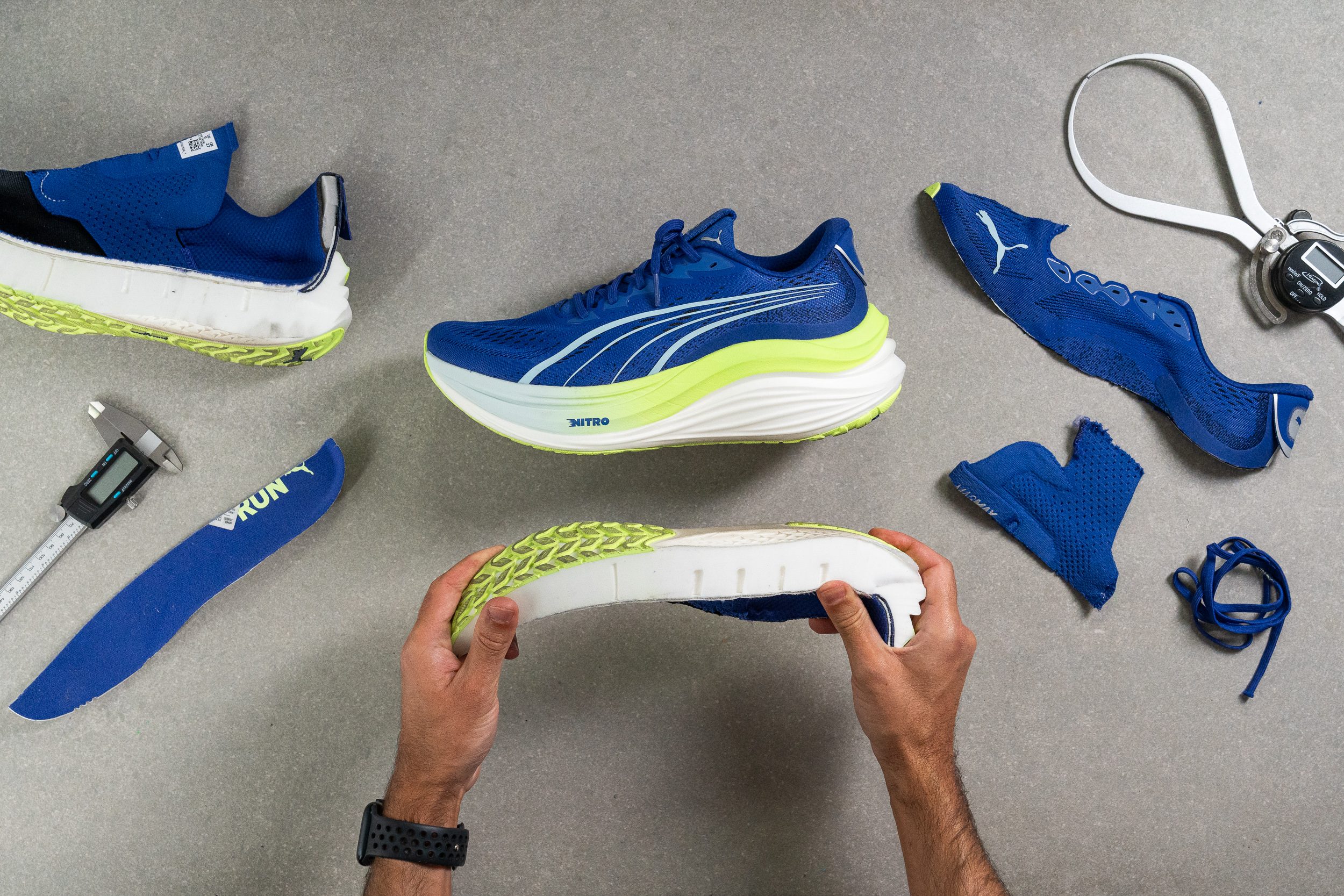
Amortiguación
Shock absorption
Las MagMax Nitro están hechas para amortiguar cada impacto y para que tus pies disfruten de toda su amortiguación paso sí y paso también. Pocas zapatillas se acercan a sus 148 SA en el talón... y mucho menos a los increíbles 139 SA en el antepié.
Vamos, que si tu prioridad es proteger tus piernas de los impactos, lo más probable es que te enamores de estas PUMA.

| Puma MagMax Nitro | 148 SA |
| Media | 129 SA |
Energy return
Aunque la absorción de impactos destaca tanto en el talón como en el antepié... su retorno de energía es una decepción. Aunque estas zapatillas tienen espuma Nitro inflada con nitrógeno, el resultado fue de solo un 55,5 % en el talón y de un 57,3 % en el antepié. Una pena, vaya.
Vale, a ver, ¿que si esto podría hacer que pases de estas zapatillas y las borres de tu carrito de la compra? Pues solo si tienes pensado usar las MagMax Nitro en los esfuerzos de velocidad. Al final es un modelo que se centra en la comodidad para los entrenamientos a ritmo lento, por lo que su bajo rebote no debería ser un problema importante.
| Puma MagMax Nitro | 55.5% |
| Media | 58.5% |
Altura de la suela en la zona del talón
A ver, el peso de estas zapatillas tiene una sólida razón de ser: su suela es enorme. El talón tiene una altura de 42,9 mm, así que se han ganado su puesto en la categoría de zapatillas de running maximalistas.
Aunque es ligeramente inferior a los 47 mm declarados por Puma, creemos que 42,9 mm son suficientes. En nuestra experiencia, hacerlas más altas incluso podría haber sido perjudicial, dada la relación peso-suela de estas zapatillas.

| Puma MagMax Nitro | 42.9 mm |
| Media | 34.8 mm |
Altura de la suela en el antepié
El antepié también es más bajito de lo previsto, con 33,3 mm, pero sigue siendo mucho más alto que el de la mayoría de las zapatillas de running, y es claramente ideal para los corredores de metatarsos y de mediopié. Estas zapatillas nos parecen fantásticas para las personas que están buscando olvidarse del suelo y disfrutar de la máxima protección bajo los pies.
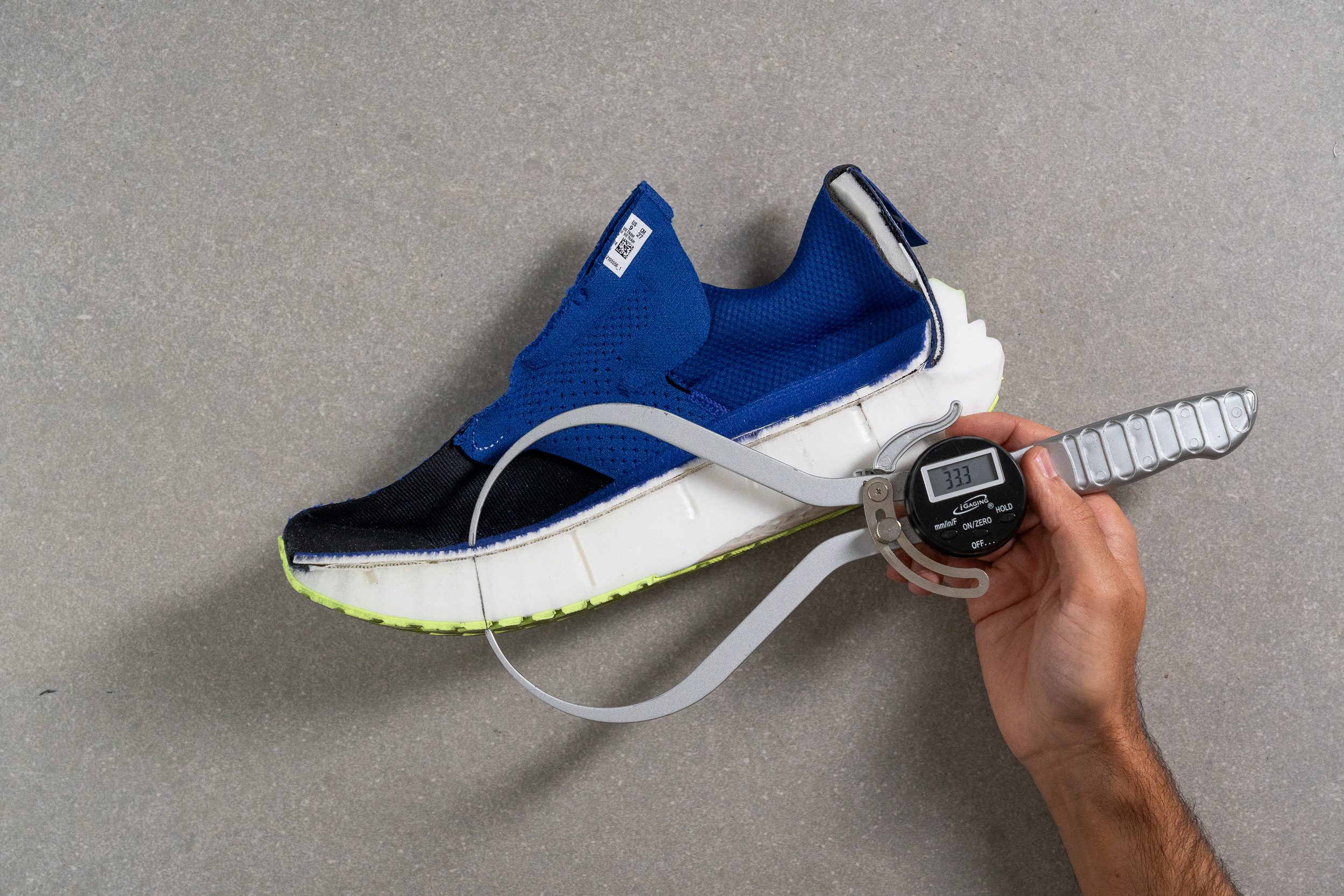
| Puma MagMax Nitro | 33.3 mm |
| Media | 26.2 mm |
Drop
Si eres bueno con los números, puede que ya lo hayas calculado, pero por si acaso te lo decimos nosotros: las MagMax Nitro tienen un drop de 9,6 mm. Esto hace que sean incluso mejores para los talonadores en comparación con el drop de 8 mm declarado por Puma, aunque la diferencia de 1,6 mm no sea alta.

| Puma MagMax Nitro | 9.6 mm |
| Media | 8.6 mm |
Suavidad de la mediasuela
Algunas superzapatillas de entrenamiento combinan dos espumas diferentes, pero Puma nos sorprendió al utilizar solo la espuma Nitro, dejando fuera a la Nitro Elite, que es un enfoque diferente al de las Deviate Nitro 3. Aunque hubiera sido genial contar con su espuma de primera en estas zapatillas, entendemos que ayudó a mantener su precio más bajo que el de algunas de sus competidoras.
La Nitro es una espuma con infusión de nitrógeno que proporciona ligereza y un retorno de energía sólido, ofreciendo una pisada mucho mejor que casi cualquier otra espuma de nivel medio del mercado. El uso de una sola placa en lugar de una configuración doble también beneficia a la durabilidad, ya que elimina el riesgo de que las capas se separen con el tiempo.

En nuestra opinión, como estas zapatillas tienen una suela tan alta, Puma no podía permitirse que la espuma fuera demasiado blanda. Nuestro durómetro marcó 18,3 HA, un resultado equilibrado que les va como anillo al dedo a las MagMax.
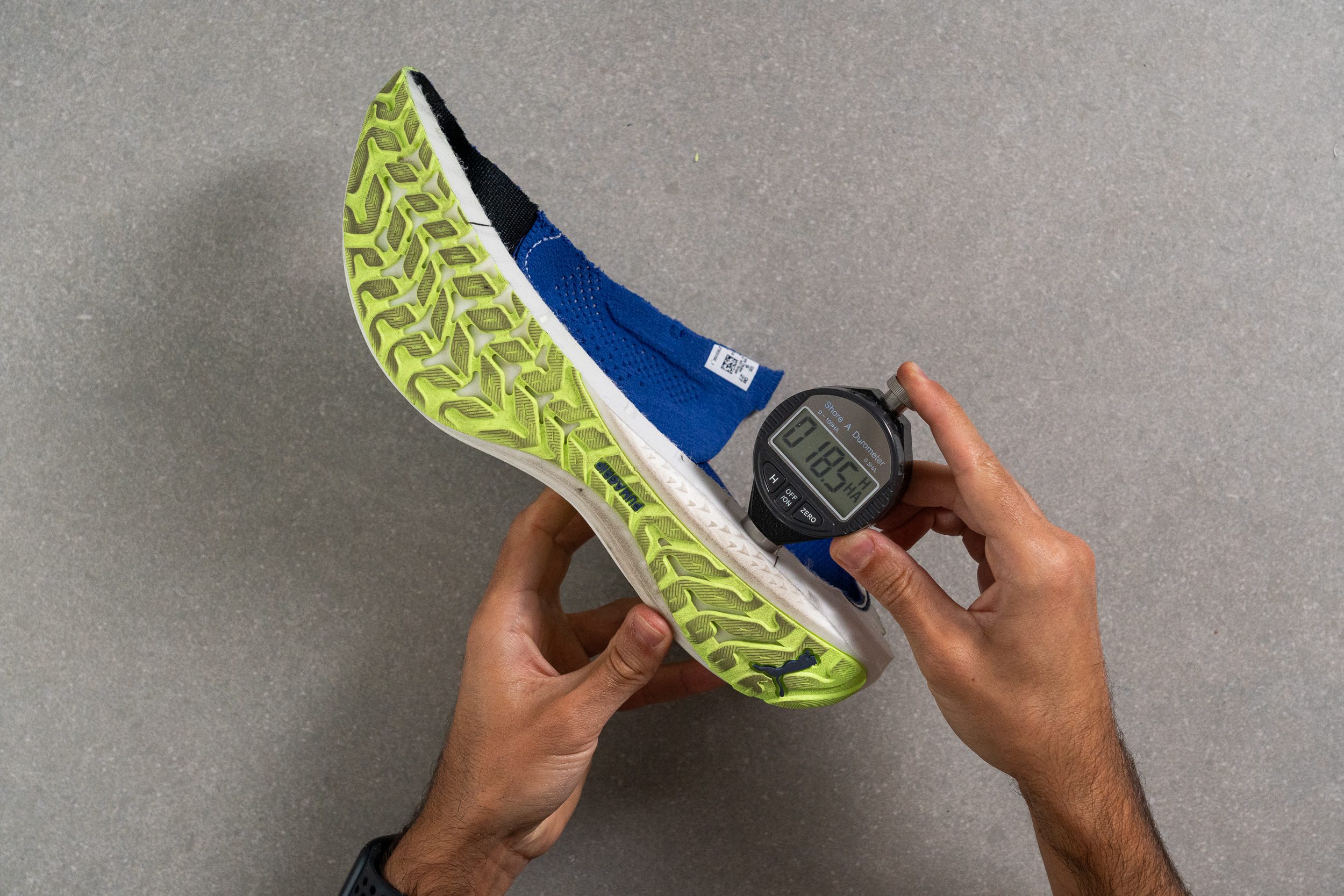
| Puma MagMax Nitro | 18.3 HA |
| Media | 20.4 HA |
Rocker
Las MagMax Nitro tienen un rocker pronunciado que empieza 10 cm antes de su parte delantera, y que nos parece esencial para favorecer las transiciones teniendo en cuenta lo alta que es su suela. El talón también tiene una curvatura importante, crucial para los talonadores, sobre todo los que aterrizan fuerte con el retropié. Sin ella, tendrían dificultades para avanzar con suavidad.
En general, el rocker nos parece suave y natural, haciendo que la pisada sea fluida en unas zapatillas de running tan maximalistas.
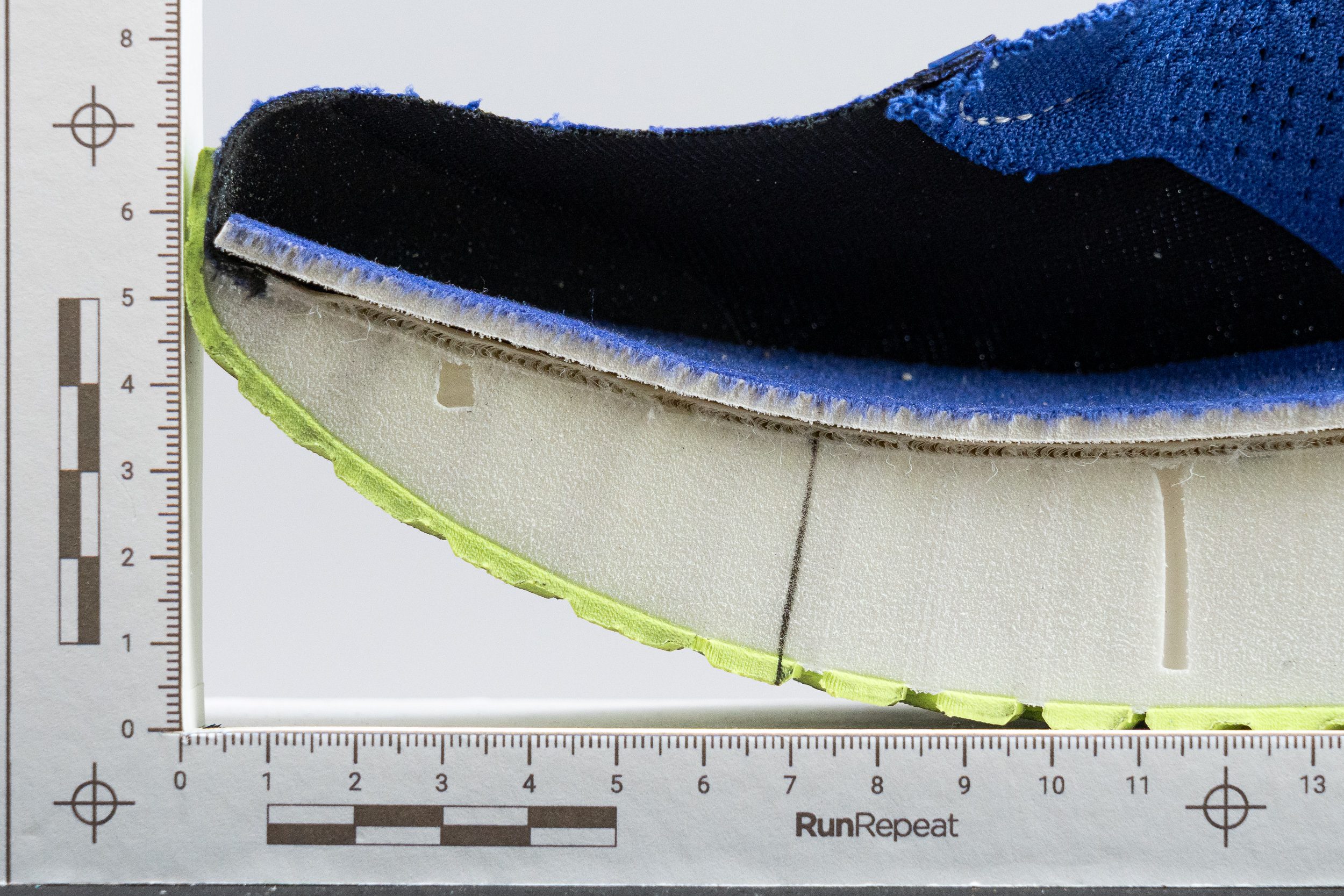
Tallaje y ajuste
Talla
Las Puma MagMax Nitro tallan bien (72 votos).
Anchura / Ajuste
Cuando medimos las MagMax Nitro, descubrimos que son un poco más anchas que el estándar de esta marca, ya que alcanzan unos 97,1 mm en su punto más ancho. Creemos que esta mejora supone una ventaja para los entrenamientos que duran más de una hora.
Para nosotros está claro que este sutil pero importante cambio se hizo porque, a diferencia de otras zapatillas de Puma, las MagMax Nitro están diseñadas al 100 % para largas distancias, en las que tener suficiente espacio interno es crucial.

| Puma MagMax Nitro | 97.1 mm |
| Media | 95.1 mm |
Anchura de la parte delantera
La part delantera se estrecha hacia la punta, siguiendo el diseño de la mayoría de las zapatillas de Puma, así que no te esperes mucho de esta zona.
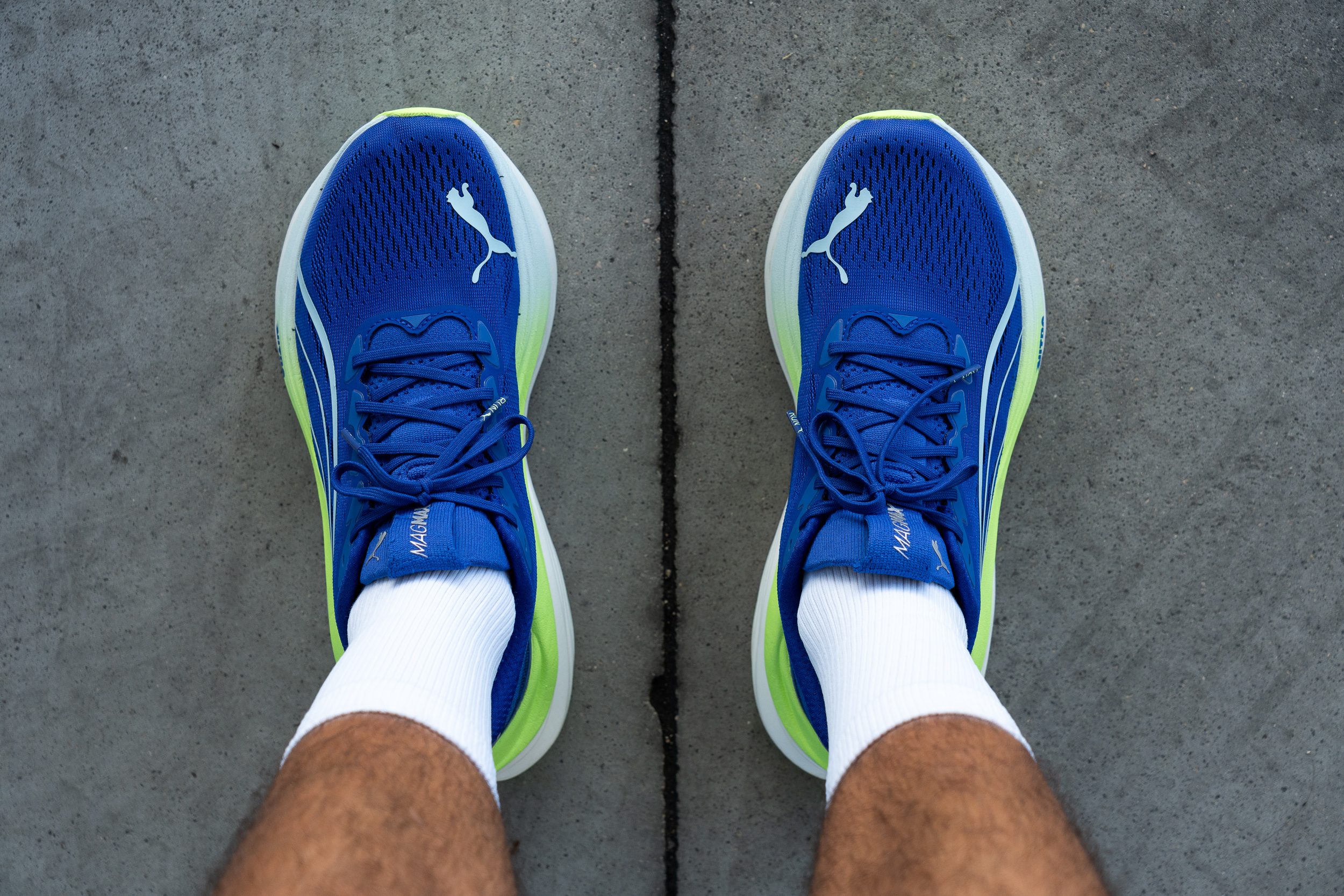
Pero bueno, creemos que 72,3 mm es una medida decente, sobre todo si se combina con el material que tiene este modelo en el upper, que es muy elástico y flexible.

| Puma MagMax Nitro | 72.3 mm |
| Media | 73.2 mm |
Altura de la parte delantera
El volumen de la zona de los dedos nos parece decente, ya que el material del upper no es restrictivo, pero está lejos de ser algo revolucionario. Sus 26,4 mm de altura están por debajo de la media en comparación con la mayoría de las zapatillas de running.
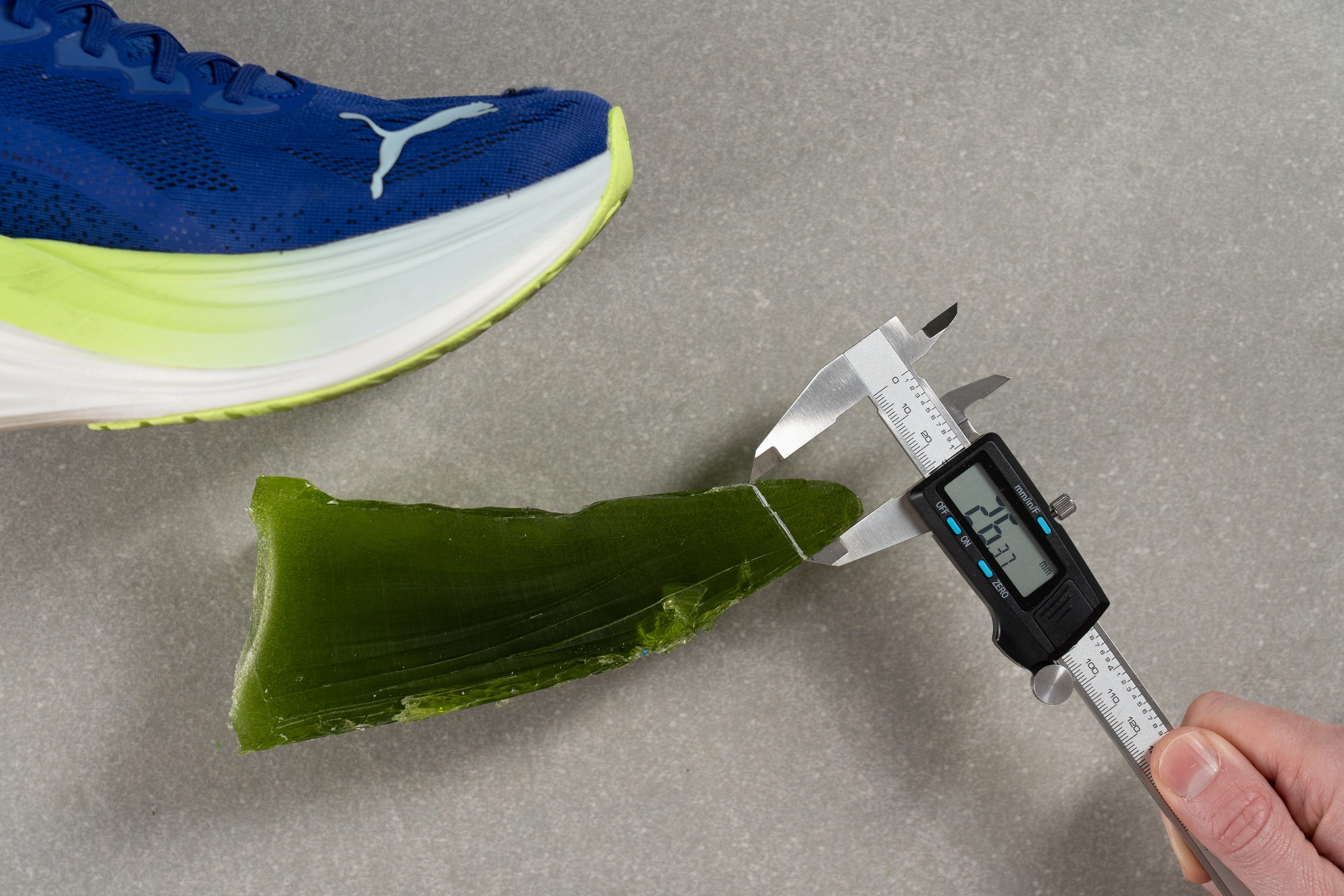
| Puma MagMax Nitro | 26.4 mm |
| Media | 27.1 mm |
Tracción / Agarre
Traction test
En nuestro laboratorio, siempre les subimos el listón a las zapatillas que tienen caucho de primera categoría, y más cuando la rivalidad de los Dassler entre PUMA (PumaGrip) y Adidas (Continental) se enciende. Sí, incluso décadas después, ¡la batalla bajo los pies continúa!
Cuando analizamos el agarre de las MagMax sobre mojado, se llevaron un sólido 0,60. Esto hace que se metan directamente en el grupo de los modelos con el mejor agarre, proporcionando una tracción segura sobre hormigón empapado, pavimento seco y todo lo demás.
| Puma MagMax Nitro | 0.60 |
| Media | 0.48 |
Diseño de la suela exterior
Podemos confirmar que las MagMax Nitro utilizan el mismo caucho (que ofrece un agarre espectacular) que las mejores superzapatillas de Puma, las Deviate Nitro Elite 3. Sin embargo, las MagMax tiene más caucho en la suela exterior, ya que no son unas zapatillas de competición.
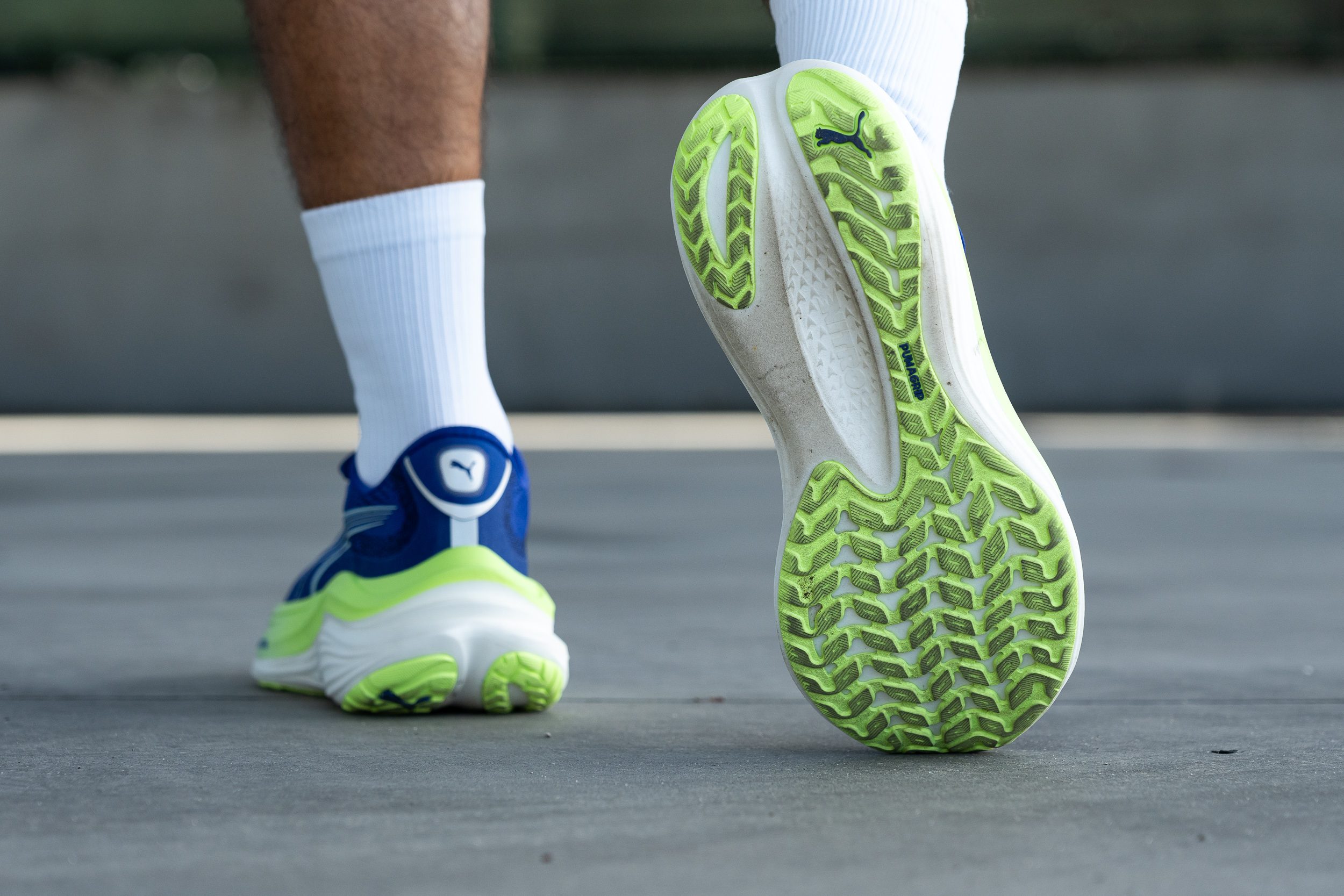
Flexibilidad / Rigidez
Con su altísima rigidez torsional y su enorme mediasuela, nos esperábamos que las MagMax Nitro fuesen un par de ladrillos.
Lo comprobamos con nuestra prueba de flexión de 30 grados, y el resultado fue parecido al de las zapatillas de tempo con una placa de nylon. Aunque no es un mal resultado, creemos que tampoco es ideal paralas personas que estén buscando un par para caminar todo el día o para salir a pasear: son un poquito demasiado rígidas si tu prioridad número 1 es la comodidad.
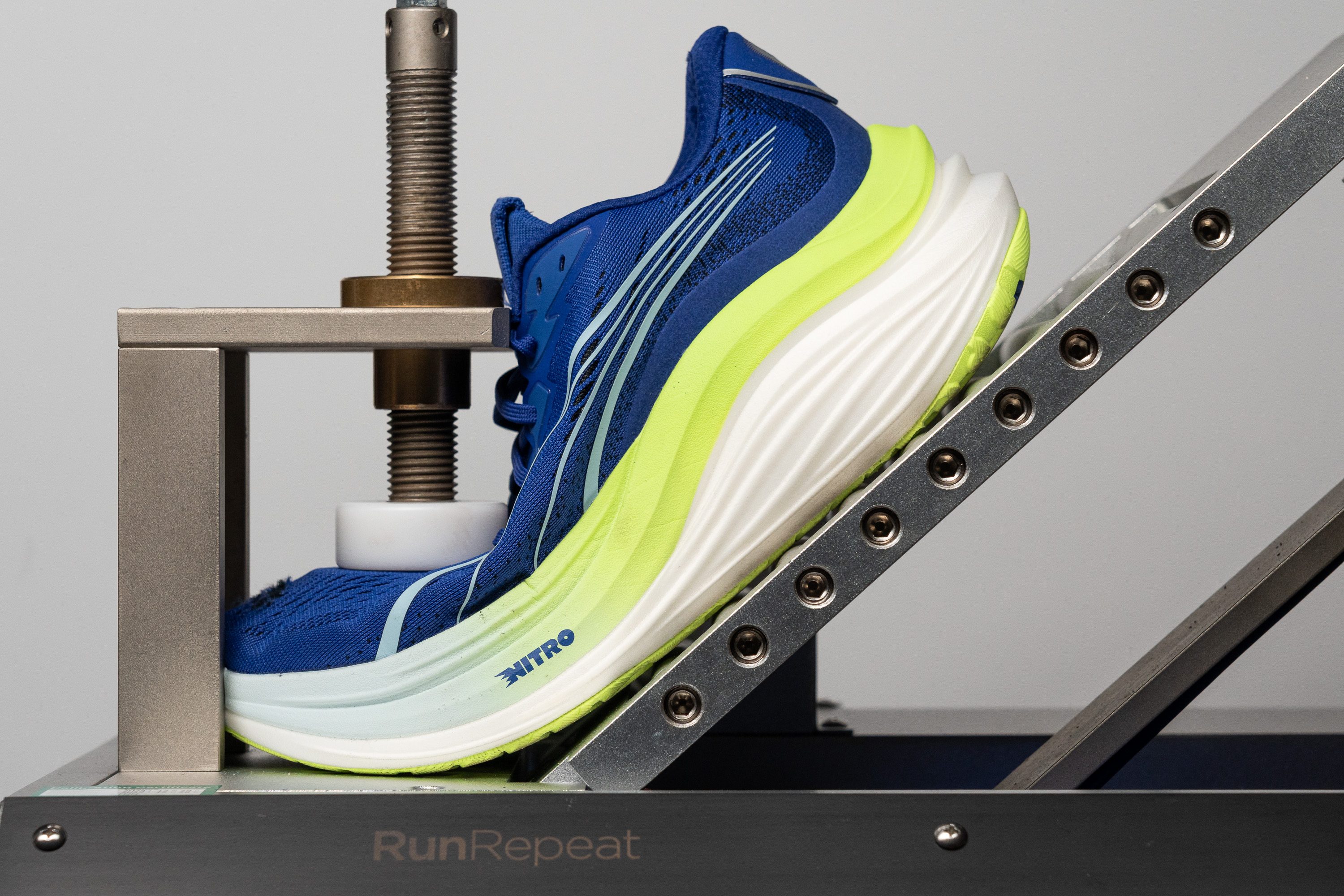
| Puma MagMax Nitro | 17.9N |
| Media | 15.3N |
Rigidez en frío (%)
Obtuvimos exactamente el mismo resultado después de meter estas zapatillas en el congelador otros 20 minutos, ¡algo muy poco común en nuestras pruebas de laboratorio!
| Puma MagMax Nitro | 0% |
| Media | 33% |
Peso
Con respecto al peso, sentimos que estas zapatillas nos han dado una de cal y otra de arena. Por un lado, hasta nos parecen ligeras si tenemos en cuenta esos rascacielos hechos suela que tienen, ya que solo pesan 291 g. Por otro, entran en la categoría de "zapatillas pesadas" si las comparamos con un modelo estándar de entrenamiento diario o incluso de running.
En nuestra opinión, si el peso no es un factor importante para ti, las MagMax Nitro probablemente te gusten. Pero si prefieres unas zapatillas que casi no sientas en los pies, mejor pasa de ellas.

| Puma MagMax Nitro | 10.3 oz (291g) |
| Media | 9.3 oz (264g) |
Transpirabilidad
En cuanto sacamos de la caja las MagMax Nitro azules que compramos, nos dimos cuenta de que la parte superior era mullida y muy cómoda, aunque nos hizo dudar un poco de su transpirabilidad, así que nos las llevamos al laboratorio para averiguar si podía proporcionar suficiente flujo de aire.
Comenzamos con nuestra típica prueba de humo, conectando nuestra máquina a una pieza impresa en 3D y diseñada a medida para dirigir el humo hacia la parte delantera. Nos quedamos bastante contentos con su rendimiento, así que les dimos a estas zapatillas un sólido 4/5 en nuestra escala.
También utilizamos una luz para saber dónde están los agujeritos de ventilación de la parte delantera y de la zona media. Vimos que Puma buscaba un equilibrio entre el flujo de aire y la sujeción, con menos ventilación desde el mediopié hasta el talón, una elección que nos pareció lógica con lo altísimo que es el talón de estas zapatillas.
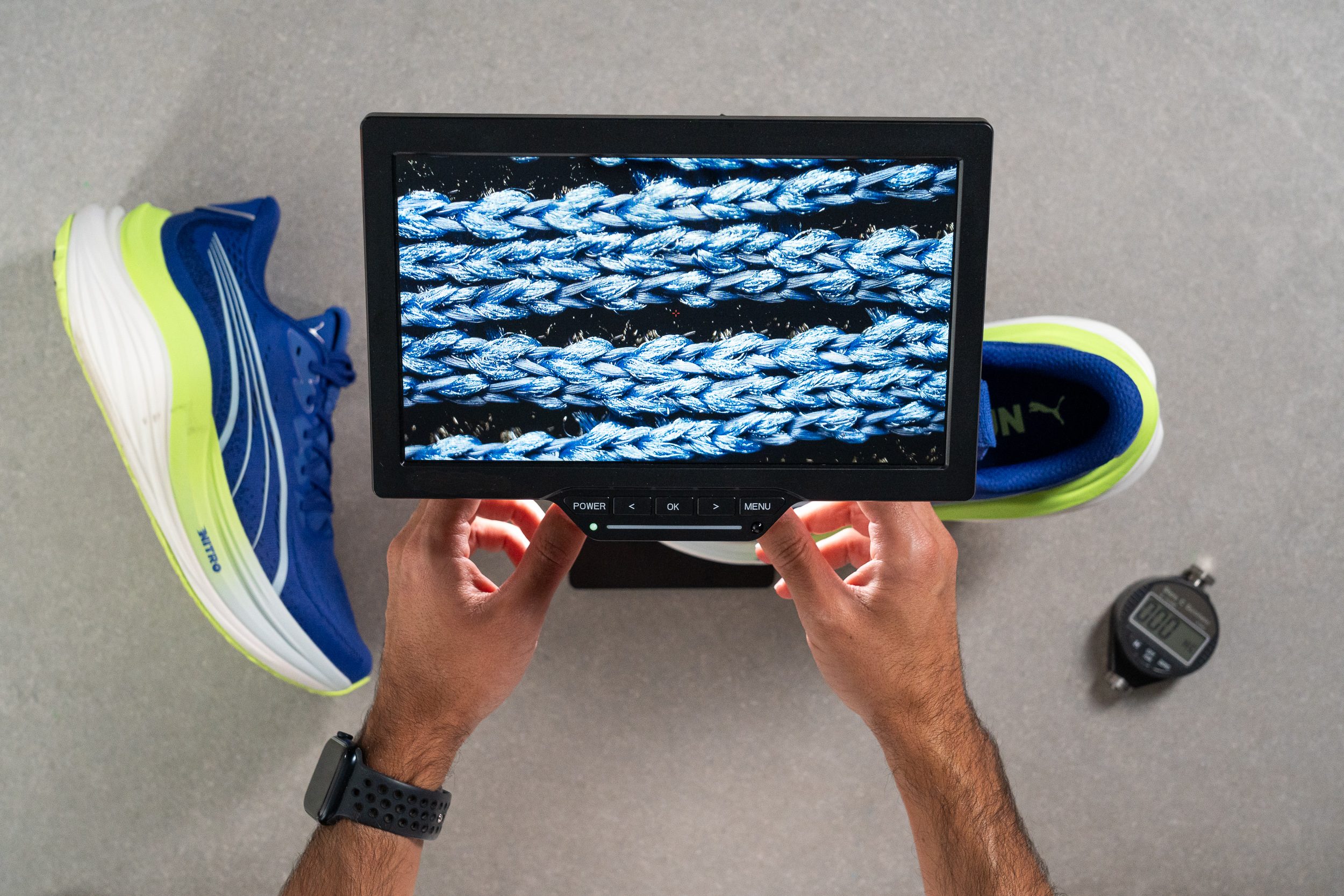
Bajo el microscopio, nos encontramos con una parte superior de malla de ingeniería sorprendentemente estándar. Aunque Puma suele experimentar con materiales y diseños únicos, esta parte superior se parecía a la de muchas otras zapatillas de entrenamiento diario.
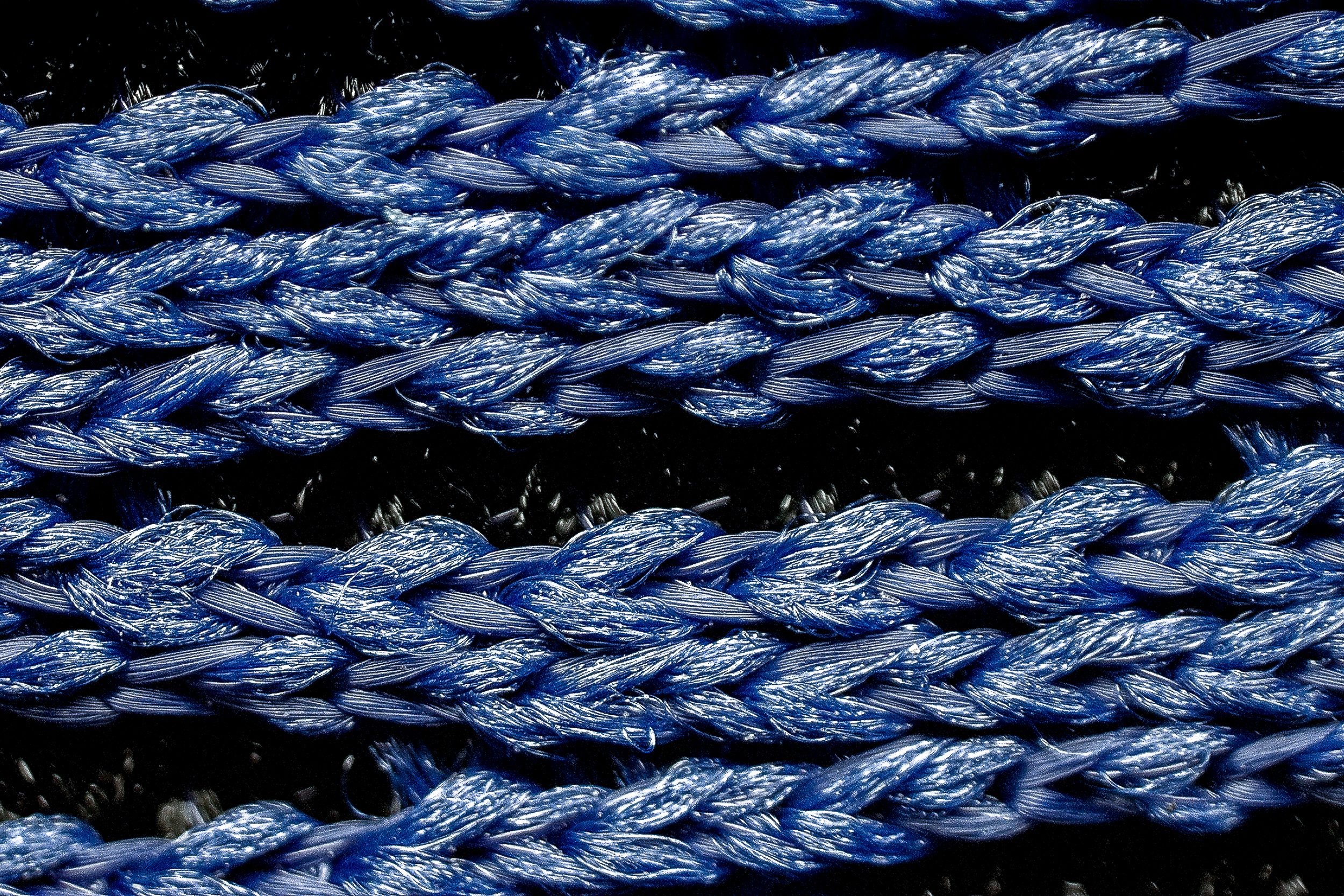
Puma suele utilizar superposiciones termoplásticas (PWRTAPE) para mejorar la estructura de la parte superior de sus modelos. Nos pusimos manos a la obra para comprobar si estas superposiciones restringían el flujo de aire, pero descubrimos que no es así.
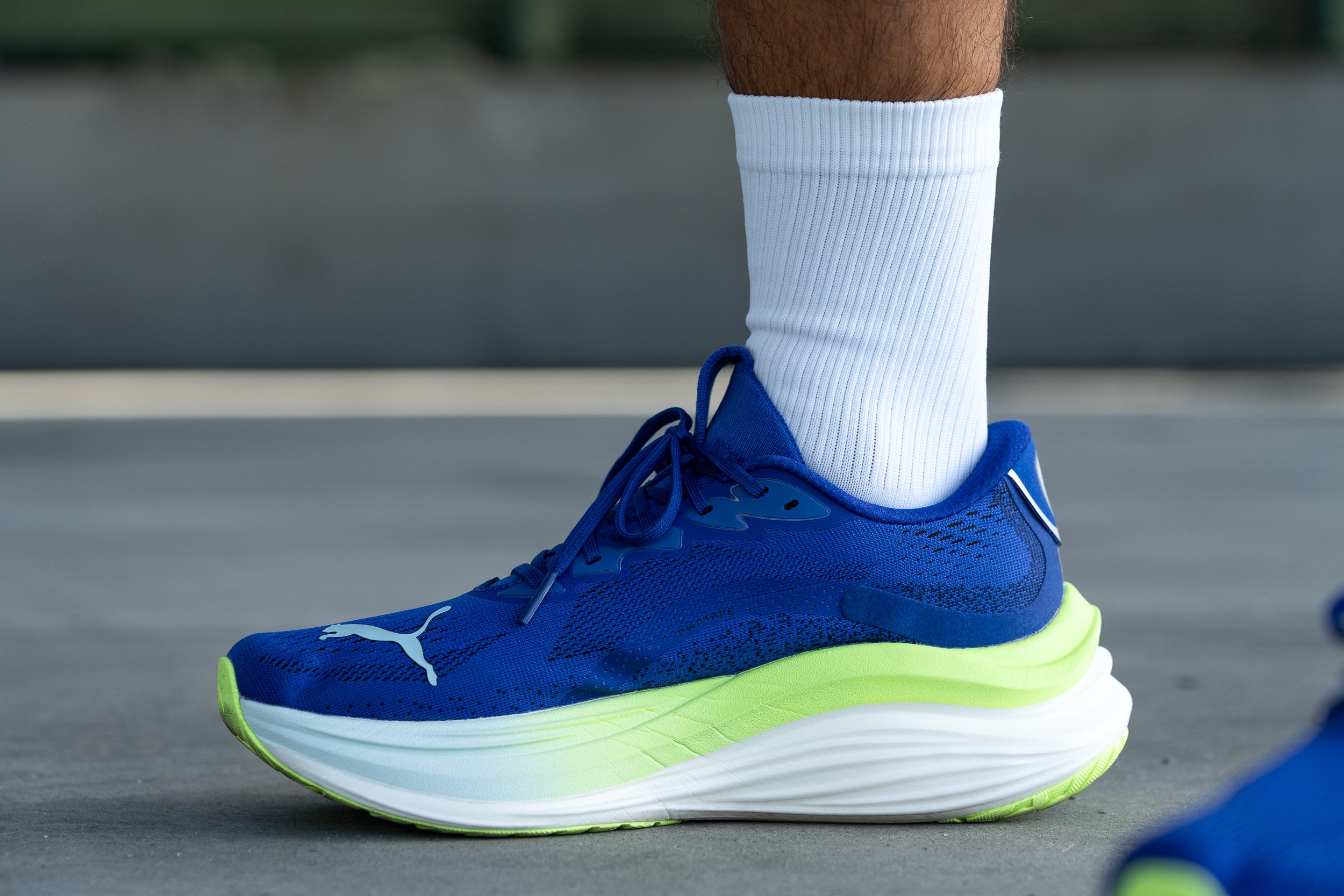
En general, pensamos que esta parte superior se adapta muy bien a estas zapatillas, con todo su acolchado y su buena ventilación. Vamos, ¡que para nosotros ha aprobado con nota!
| Puma MagMax Nitro | 4 |
| Media | 3.7 |
Estabilidad
Prueba de estabilidad lateral
Las Puma MagMax Nitro están diseñadas para los corredores neutros, pero para poder lidiar con esa mediasuela tan grande, Puma ha añadido varias características de estabilidad, incluyendo paredes laterales, una gran extensión de la suela y una estructura muy rígida.
Por estas razones, creemos que los corredores con necesidades moderadas de estabilidad pueden utilizar estas zapatillas, aunque seguimos pensando que su objetivo principal deberían ser los corredores neutros, independientemente de su técnica de carrera.
Rigidez torsional
Cuando el talón de unas zapatillas supera los 40 mm y el antepié los 30 mm, hacer unas zapatillas torsionalmente flexibles se convierte en todo un reto.
En nuestra experiencia, tener una rigidez torsional de 5/5 proporciona un leve aumento de la estabilidad al mantener las fuerzas centradas en las MagMax Nitro. Eso sí, una rigidez tan alta puede hacer que estas zapatillas resulten un poco menos cómodas, pero creemos que es necesaria para mantener el control con una suela tan gigante.
| Puma MagMax Nitro | 5 |
| Media | 3.5 |
Rigidez del contrafuerte del talón
En nuestras pruebas, descubrimos que el contrafuerte de talón ofrece un sólido equilibrio con su 3/5 en rigidez.
Es lo suficientemente firme como para proporcionar sujeción sin sentirse demasiado rígido. En nuestra opinión, este diseño se centra en satisfacer a una amplia gama de corredores, y lo ha conseguido.
| Puma MagMax Nitro | 3 |
| Media | 2.9 |
Anchura de la mediasuela - antepié
En cuanto nos pusimos a trabajar con estas zapatillas en nuestro laboratorio ya nos parecieron grandes, pero no fue hasta que las medimos que nos dimos cuenta de lo enormes que son. Cuando cogimos nuestros calibres digitales para medir la anchura del antepié, nos quedamos boquiabiertos al ver que ponía 126,9 mm.
Son unas de las zapatillas más anchas que hemos analizado en nuestro laboratorio, y hemos descubierto que su amplia base es la razón detrás de toda la estabilidad que sentimos, ¡incluso siendo un par de rascacielos! Son como conducir un todoterreno gigante: no están pensadas para los giros rápidos o los acelerones bruscos, pero son comodísimas para ir por la autopista.
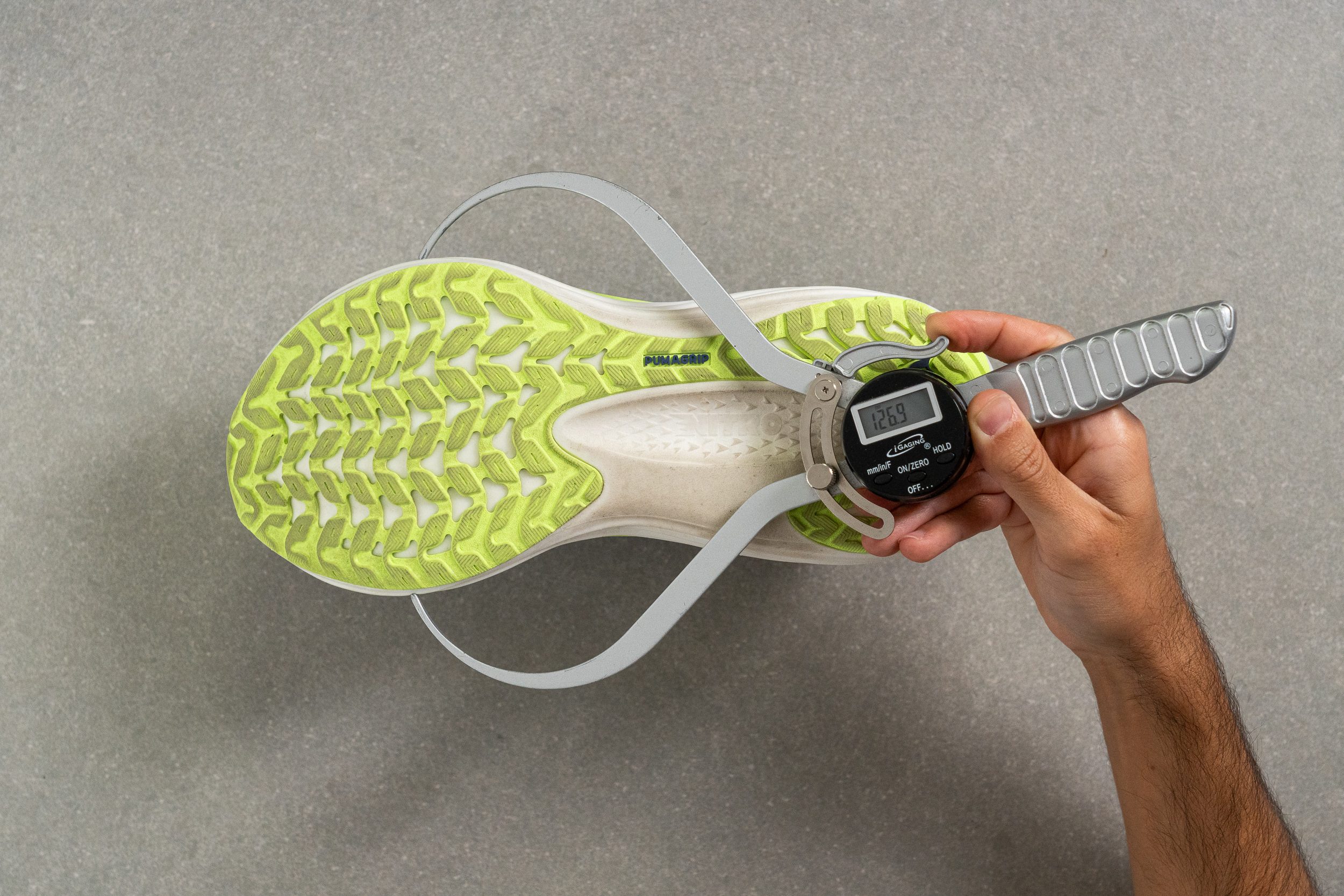
| Puma MagMax Nitro | 126.9 mm |
| Media | 114.4 mm |
Anchura de la mediasuela - talón
El talón sigue el mismo estilo de diseño que el antepié: es bastante ancho en comparación con 9 de cada 10 zapatillas de running del mercado actual. Cuando lo medimos nos dio 105,8 mm, que debería ser más que suficiente para los talonadores que requieren una estabilidad extra en comparación con los típicos modelos neutros.

| Puma MagMax Nitro | 105.8 mm |
| Media | 90.7 mm |
Durabilidad
Durabilidad de la parte delantera
La ventaja de utilizar una parte superior de malla de ingeniería clásica es que la durabilidad tiende a ser fiable, incluso con todos esos agujeritos que favorecen el flujo de aire, sobre todo en comparación con el knit.
Les dimos un 3/5 en la prueba Dremel. Aunque no es un resultado espectacular, es suficiente para soportar el desgaste típico de las carreras por carretera.
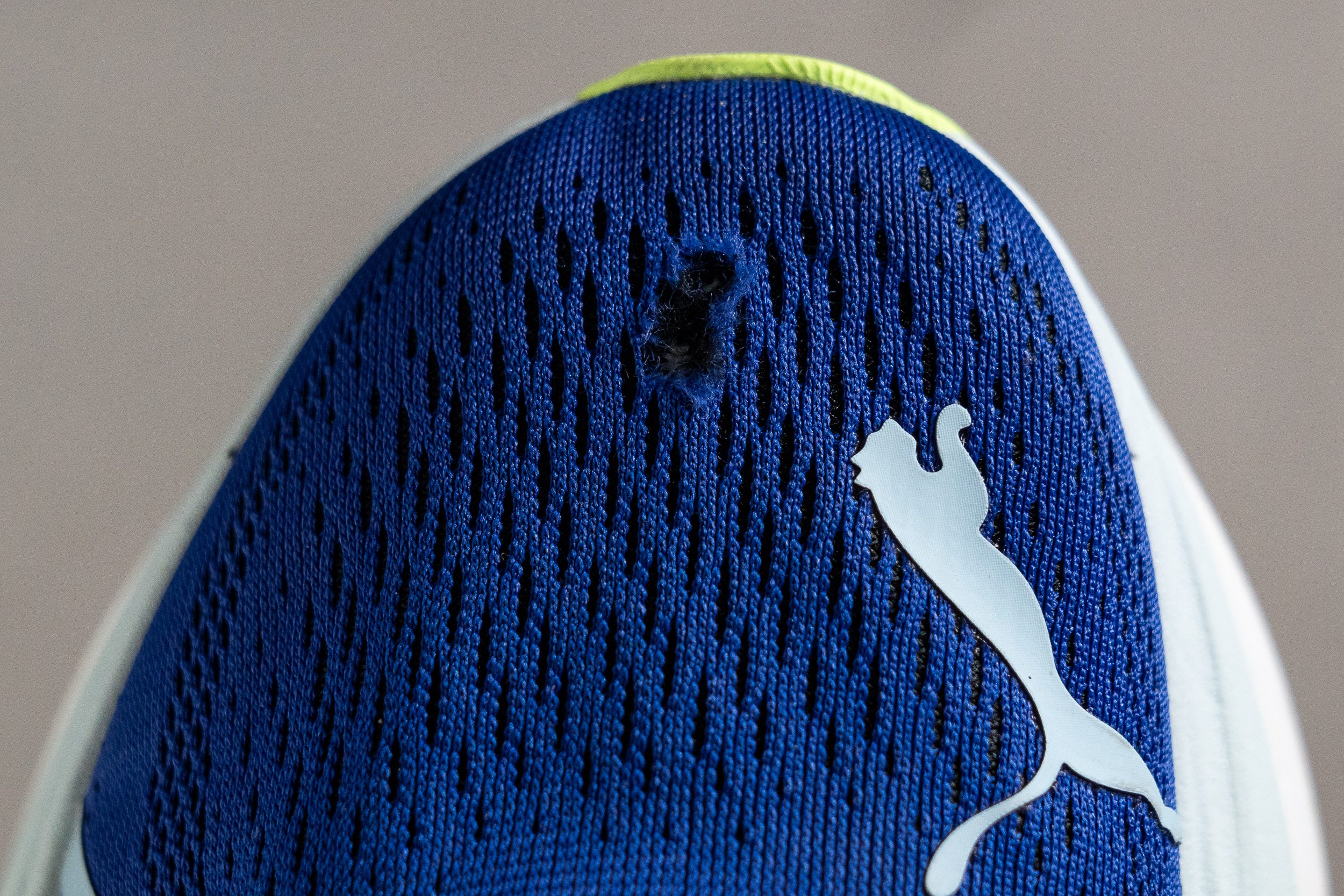
| Puma MagMax Nitro | 3 |
| Media | 2.6 |
Durabilidad del acolchado del talón
Aunque las MagMax Nitro se llevaron el mismo resultado en esta prueba que en la anterior, un 3/5, si comparamos su talón con el de sus competidoras... es como que nos sabe a poco. Pero bueno, esta puntuación está lejos de ser decepcionante.
El problema está en el forro, que no es liso, sino que tiene agujeritos pequeños de ventilación. Aunque mejoran la transpirabilidad, también crean puntos débiles más propensos a sufrir daños.

| Puma MagMax Nitro | 3 |
| Media | 3.4 |
Dureza de la suela
El caucho de la suela exterior, que es sorprendentemente blando (obtuvo un resultado de 74,0 HC en nuestro durómetro), nos proporcionó una tracción excepcional, algo que esperábamos del conocidísimo PumaGrip.

Nuestras pruebas confirmaron que las MagMax Nitro utilizan el mismo caucho ultra adherente que las mejores superzapatillas de Puma, las Deviate Nitro Elite 3. Sin embargo, las MagMax tienen más caucho protegiendo la suela, y creemos que dicha capa también será más ancha.

| Puma MagMax Nitro | 74.0 HC |
| Media | 79.2 HC |
Durabilidad de la suela
A ver, su durabilidad no es la mejor, pero la verdad es que ya nos lo esperábamos de un caucho PumaGrip tan blando, además de que su tracción es fantástica incluso en caminos de tierra.
Nuestro medidor de desgaste de neumáticos marcó que los daños tenían una profundidad de 1,4 mm. Es un resultado más alto de lo que nos gustaría, y podría hacer que las zapatillas de los corredores pesados, que son más propensos a tener este problema, se desgastasen antes de tiempo. De todos modos, creemos que esto no es demasiado preocupante para el corredor medio.
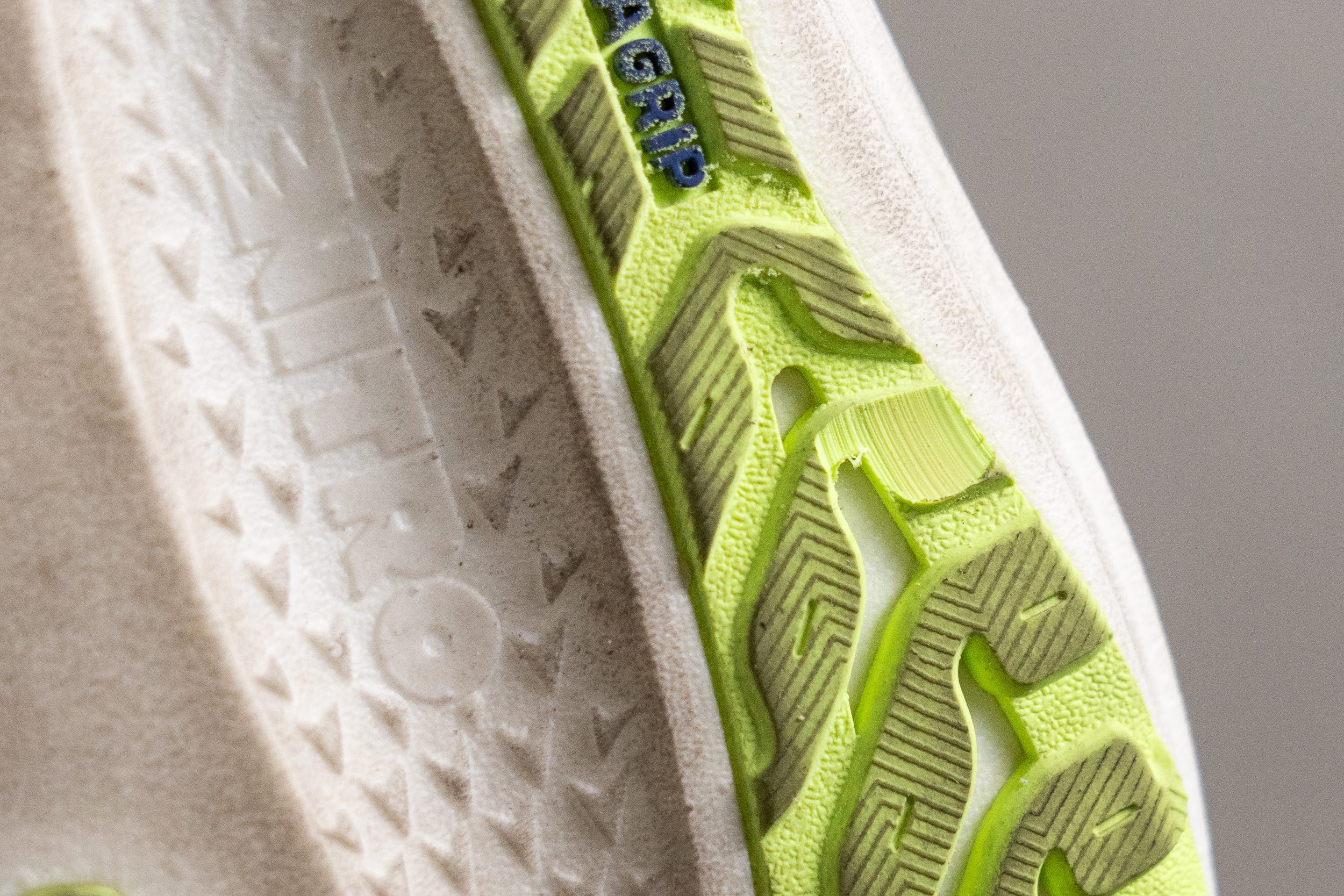
| Puma MagMax Nitro | 1.4 mm |
| Media | 1.1 mm |
Grosor de la suela
¿Que por qué pensamos así? Pues porque Puma, conociendo la baja resistencia al desgaste de su compuesto PumaGrip, utilizó 3,5 mm de grosor en su suela exterior para garantizar la durabilidad y alargar la vida útil de estas zapatillas.

| Puma MagMax Nitro | 3.5 mm |
| Media | 3.2 mm |
Varios
Grosor de la plantilla
Utilizamos nuestros calibres digitales para medir el grosor de la plantilla y nos dio solo 3,3 mm, así que es mucho más fina de lo que nos esperábamos para estas zapatillas. Aunque bueno, vale, igual nos dejamos llevar un poco pensando que todo en las MagMax Nitro iba a ser tamaño XXL.
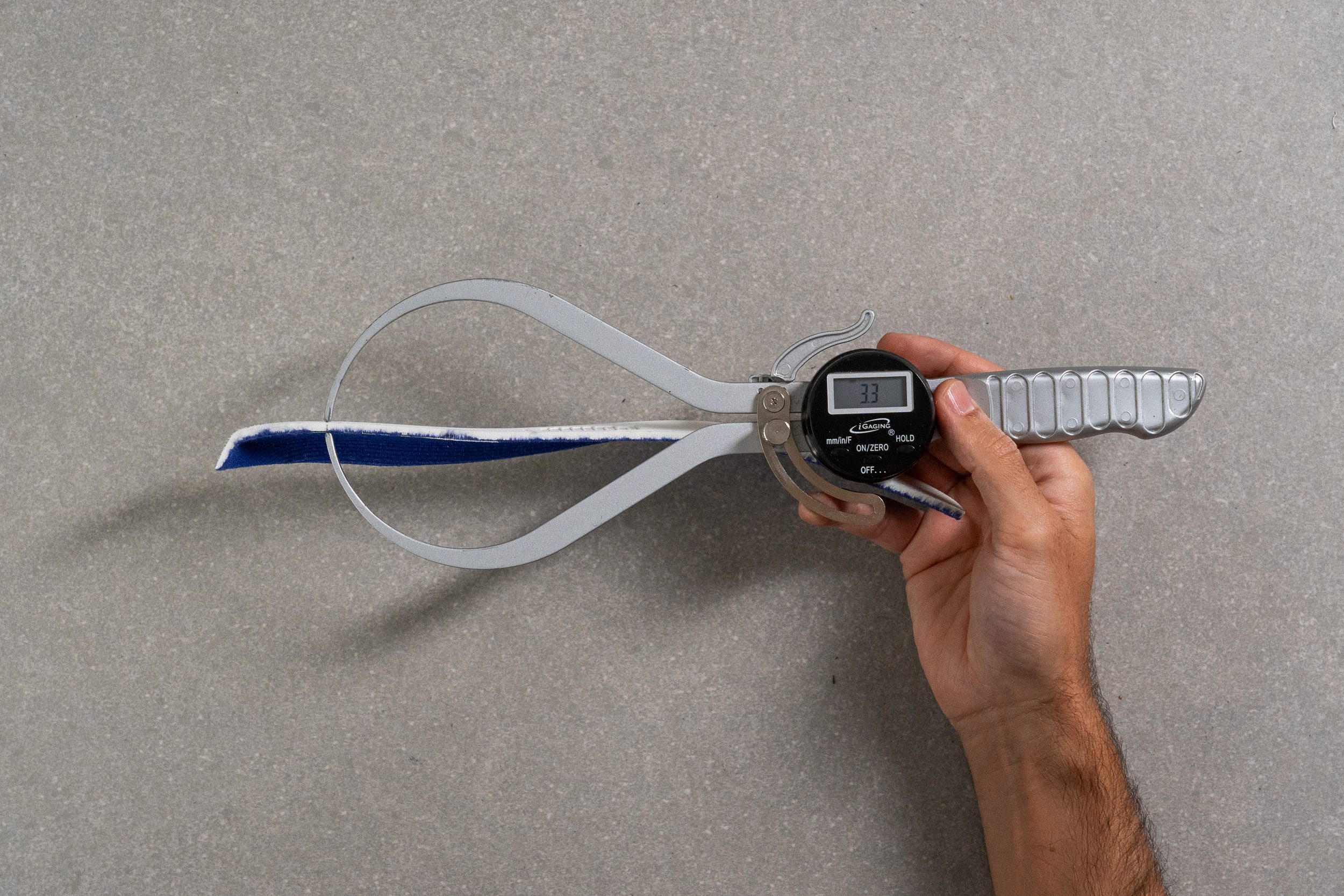
| Puma MagMax Nitro | 3.3 mm |
| Media | 4.5 mm |
Plantilla extraíble
La plantilla original puede sustituirse por una estándar, pero así no aprovecharías la que traen estas zapatillas que tiene forma de cubo y es comodísima, además de que mejora el cierre del talón.
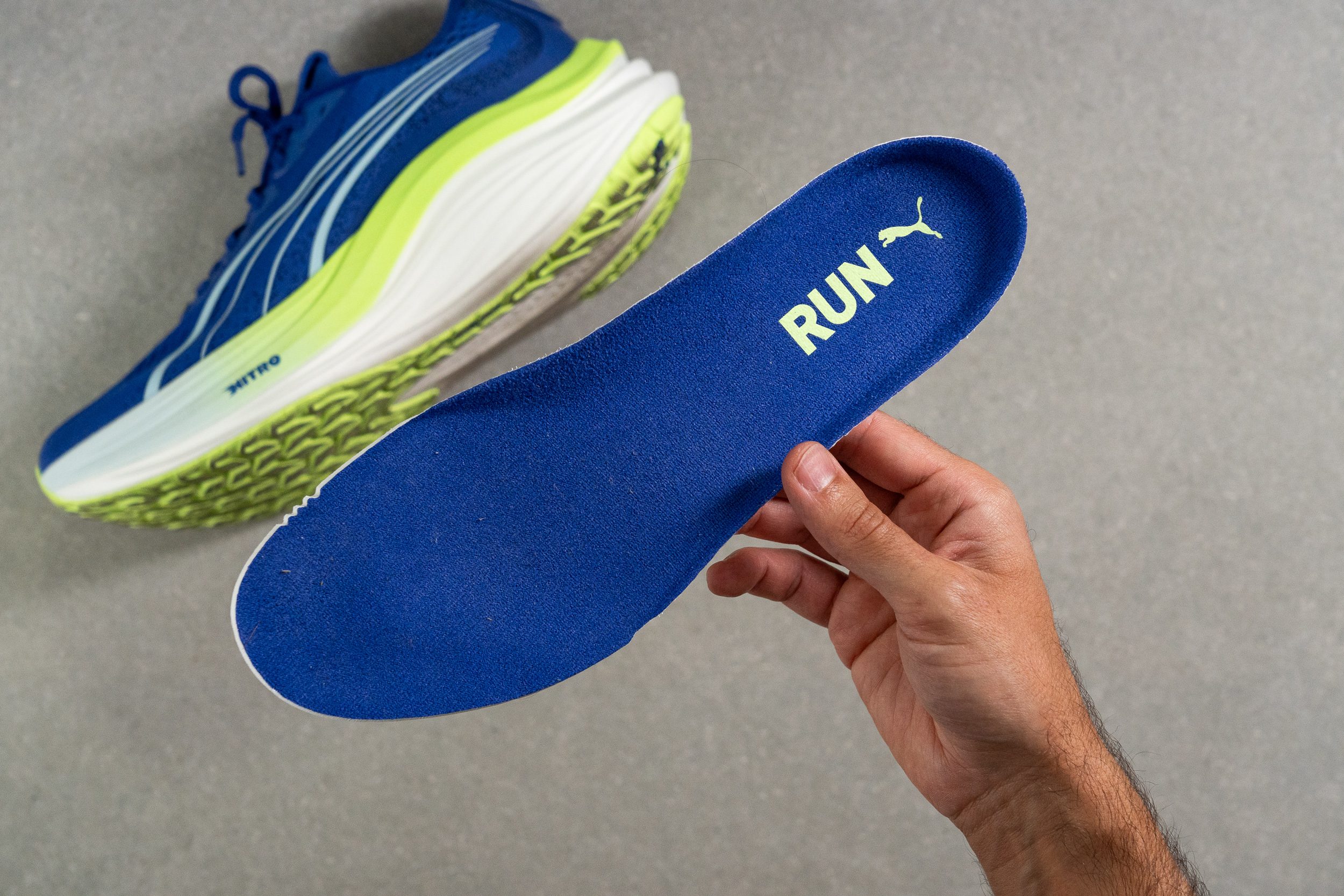
| Puma MagMax Nitro | Sí |
Rigidez de la mediasuela en frío (%)
Después de meter las MagMax Nitro en el congelador durante 20 minutos, volvimos a analizarlas con nuestro durómetro.
Y, la verdad, el resultado nos pareció decepcionante. Con 28,3 HA, el aumento en la firmeza es importante: del 54,8 %.
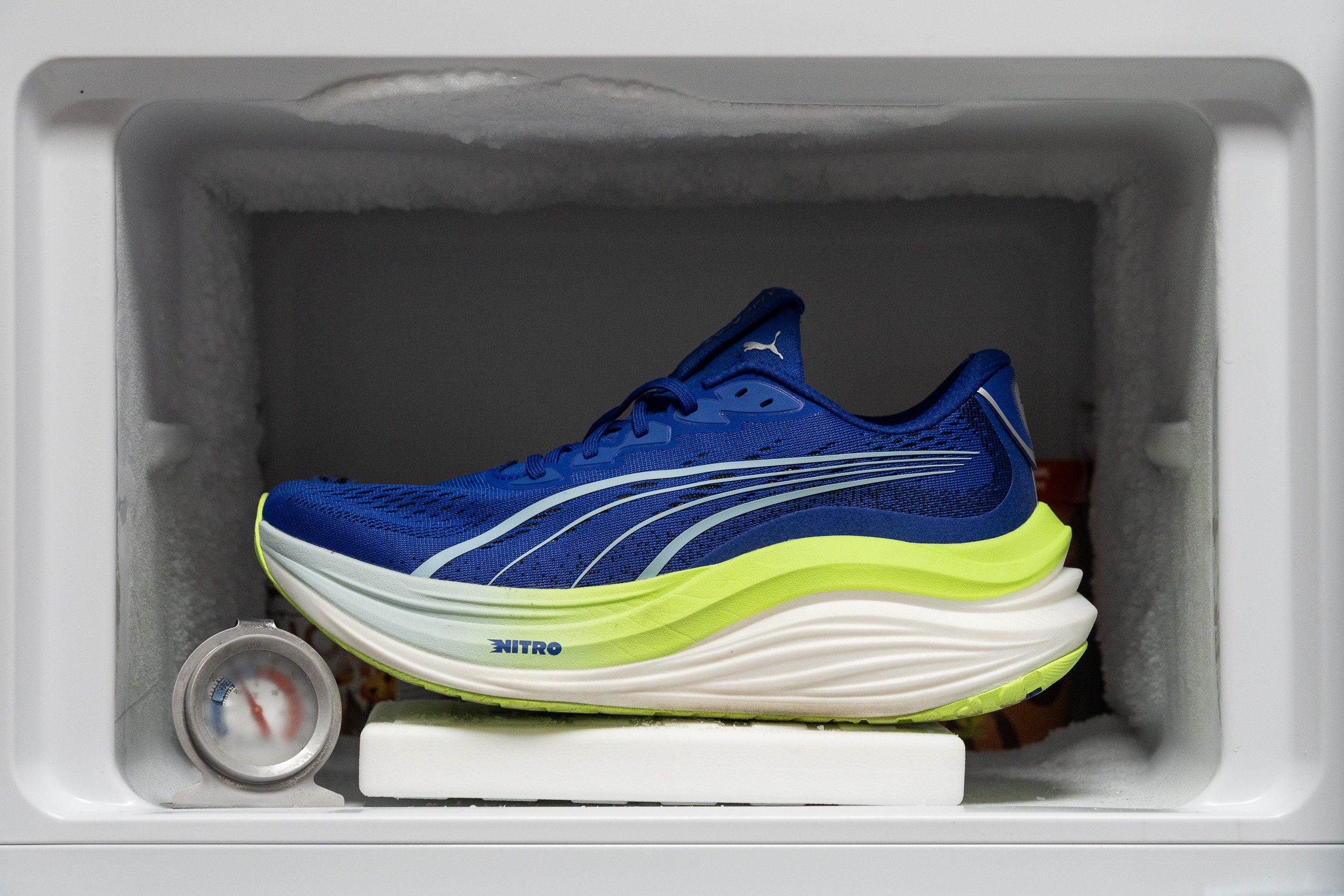
| Puma MagMax Nitro | 55% |
| Media | 24% |
Elementos reflectantes
Que las MagMax tuviesen elementos reflectantes nos hizo saltar de alegría. Puma no ha estado incorporando estos detalles en sus zapatillas de entrenamiento de élite últimamente, y en nuestra opinión esta característica es todo un acierto, ya que da seguridad. Vamos, ¡que estamos totalmente a favor!
| Puma MagMax Nitro | Sí |
Acolchado de la lengüeta
Uno de los elementos más destacados de las MagMax Nitro es su lengüeta.

A diferencia de la mayoría de las zapatillas de running, que combinan el material de la lengüeta con la parte superior, Puma nos impresionó al optar por un diseño elástico sumado a un gran tirador que nos recordó al instante a las ASICS Nimbus 26.
Con 7,1 mm de grosor y dos placas de espuma, se consigue un equilibrio perfecto entre comodidad y peso mínimo, una elección inteligente que mejora la experiencia general sin añadir volumen.

| Puma MagMax Nitro | 7.1 mm |
| Media | 5.8 mm |
Lengüeta: tipo de refuerzo
Puma eligió una lengüeta semi-reforzada para las MagMax Nitro, y creemos que es la decisión correcta. Una lengüeta sin refuerzo sería insuficiente en unas zapatillas con este precio, y un refuerzo concreto podría haber sido agobiante e incluso reducir el flujo de aire.

| Puma MagMax Nitro | Ambos lados (semi) |
Precio
Las zapatillas de running maximalistas suelen tener precios... maximalistas, y las MagMax no son una excepción. Aunque no son las superzapatillas más caras que hemos visto, tampoco son una opción económica.

¿Que si merece la pena la inversión? Pues nosotros creemos que sí. Según nuestra experiencia, la combinación de una parte superior de lujo, una amortiguación infinita y una suela exterior de primera clase hace que el precio esté totalmente justificado.
| Puma MagMax Nitro | $180 |
Tirador del talón
Las MagMax tienen una solapa en el talón que se parece a la de los modelos de la familia Adizero, como las Adidas Adizero SL2. Si la levantas, debajo tiene una sorpresita a modo de mensaje en inglés. Bouncy sabes que significa que unas zapatillas tienen rebote, y AF... qué te vamos a contar. Aquí de palabrotas nada, ¡así que pregúntale a Google!
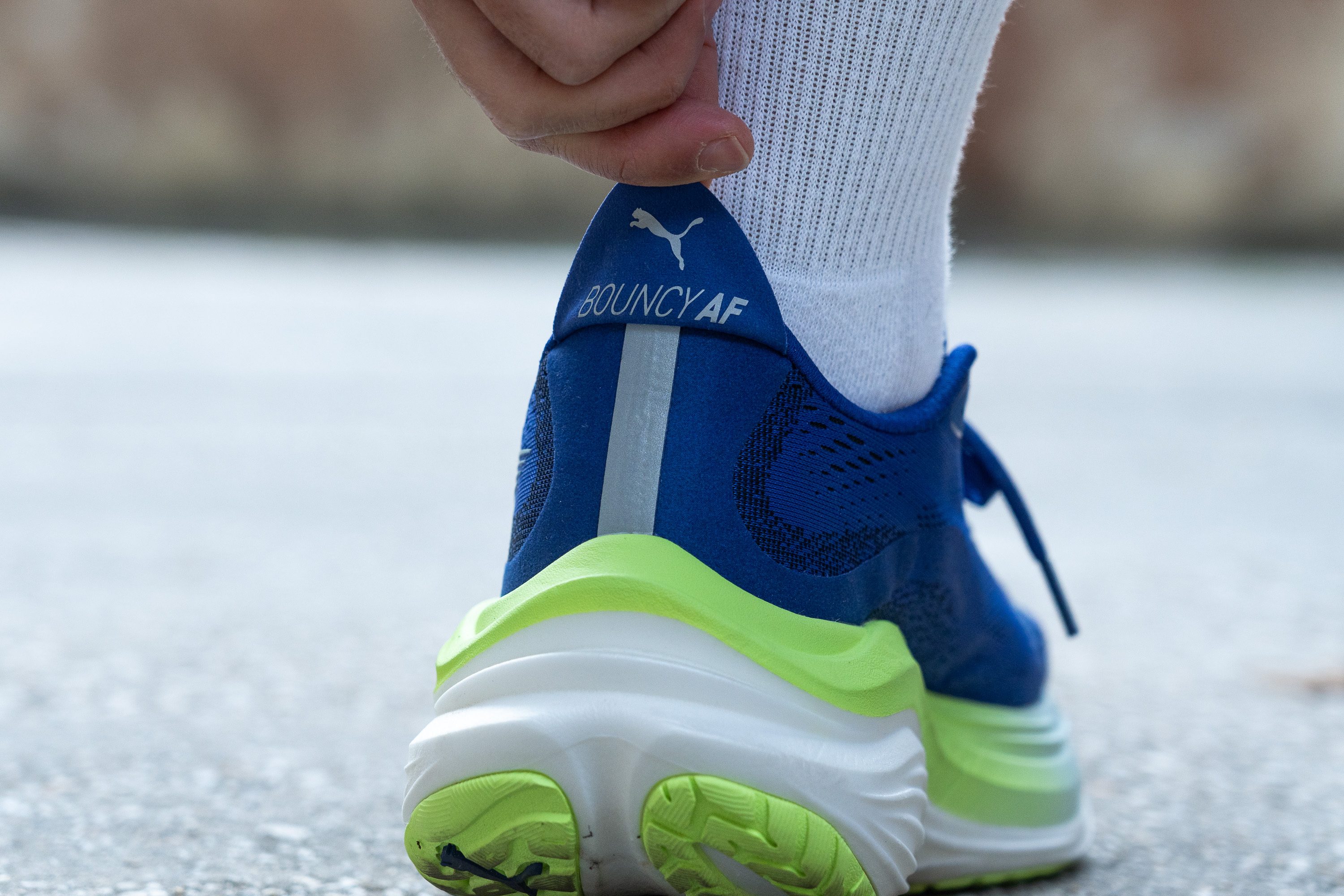
| Puma MagMax Nitro | Tirador estándar |





























































